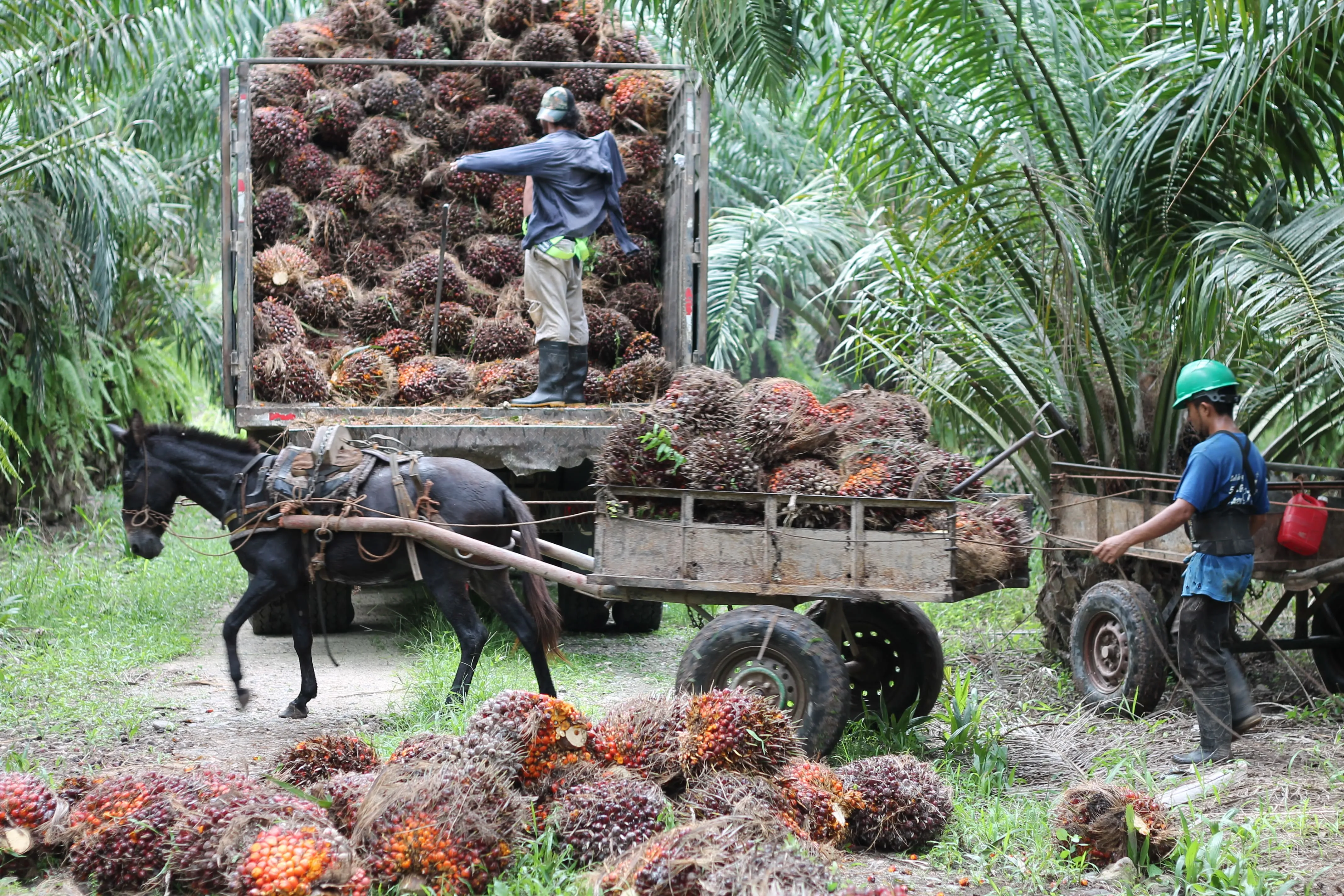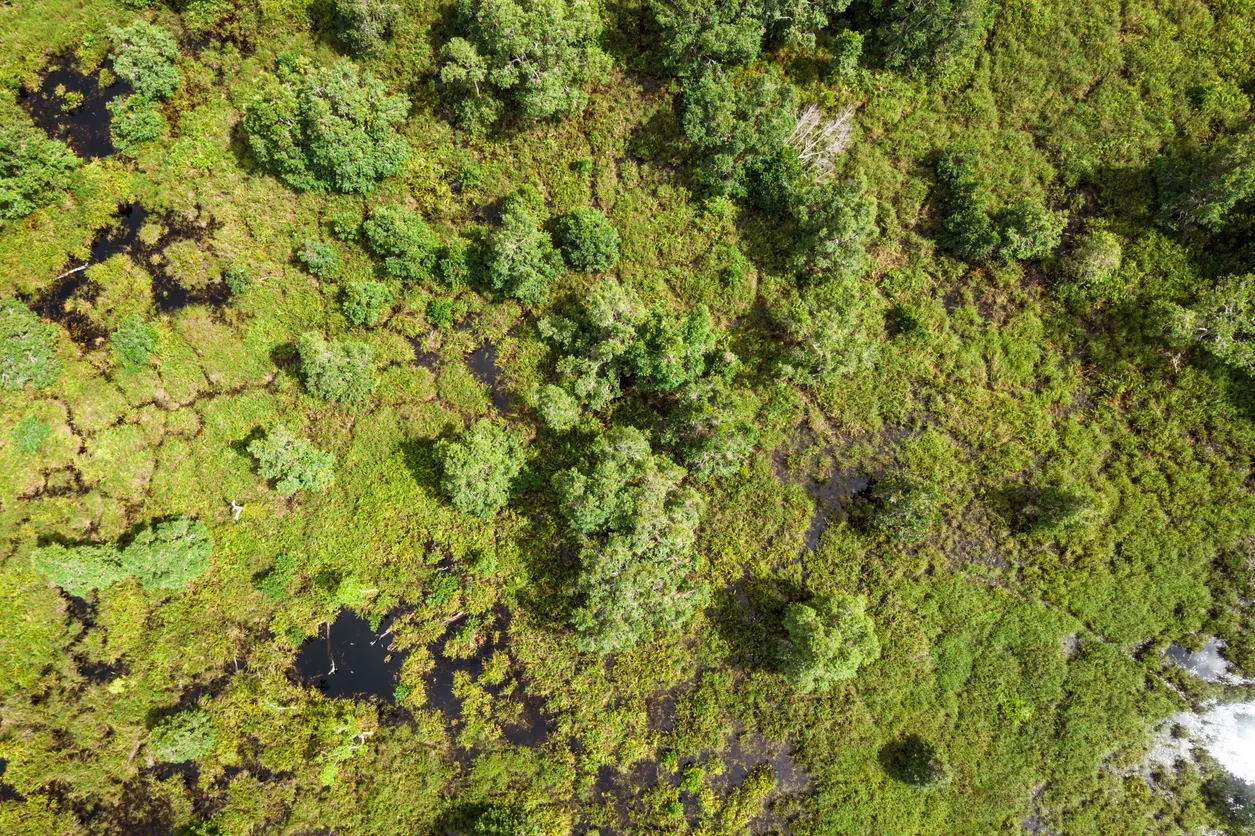
Shaping solutions for resilient forests – our key takeaways from the FSC General Assembly 2022
The Forest Stewardship Council (FSC) General Assembly explored how FSC can continue to strengthen local and global forest stewardship, reinforce the role of forests as Nature-based Solutions, and redefine the credibility and value of FSC globally.
.webp)
There has never been more of an urgent need to protect nature and people than today. In spearheading the High Conservation Value Approach, 20 years ago, the Forest Stewardship Council (FSC) was a frontrunner in addressing conservation and the rights of Indigenous Peoples and Local Communities (IPLCs) into its forest management requirements.
The FSC is a multi-stakeholder organization that unites citizens, businesses, governments, and NGOs under a common goal: protecting healthy, resilient forests for all, forever. The FSC has been a Member of the HCV Network since membership was introduced in 2014, and currently sits on the 2020-2023 Management Committee.
Last week, the HCV Network Secretariat attended the FSC General Assembly as an observer. The Secretariat hosted a panel discussion on HCV Management and Monitoring, participated as speaker in a panel about FSC regenerative rubber, and met many HCV Network Member organizations during the week to discuss the challenges and opportunities of protecting High Conservation Values (HCVs) in forestry and other commodity contexts.
However, the biggest highlight of last week was the passing of several motions which will strengthen the protection and restoration of High Conservation Values (HCVs) in the FSC system.
Scaling-up HCV protection across the landscape – Motion 23
Motion 23 will improve the protection of Intact Forest Landscapes (HCV 2), using landscape-wide approaches adapted to local conditions. The solutions presented in the motion, which include a landscape perspective, stakeholder engagement and best available data, are already core principles of the HCV Approach.
This motion will help to further embed these principles to achieve inclusive landscape management approaches, improving the protection of all HCV categories within and beyond the boundaries of FSC certified management units.
In recent years, landscape and jurisdictional approaches have become a centre-point discussion topic in many voluntary sustainability standards and initiatives, to address the increasing need for resource-efficient screening of risks to HCVs and mapping, focusing on priority areas, and the broader recognition on the importance of trans-sectoral collaboration involving multiple commodities in landscape-level conservation efforts.
Motions to improve accessing incentives and benefits for protecting HCVs
FSC recently began work on revising its Ecosystem Services Procedure. Motion 49 on the FSC Ecosystem Service Procedure as a mitigation mechanism to meet global market demand for net-zero and net-positive targets will form part of this revision.
Robustly identifying and managing High Conservation Values (HCVs) supports ecosystem services such as biodiversity, storing carbon, and purifying water. The FSC ecosystem services claims will help forest managers quantify the intangible value of their forests and accessing payments will help improve protection and restoration of HCVs.
Motion 53 supports Indigenous Peoples by incorporating the recognition of cultural services and practices (HCV 6) into ecosystem services.
Motions to scale up the restoration of forests and conservation values
Motion 37 (Required changes to the FSC Principles and Criteria to implement the Policy to Address Conversion) and Motion 45 (Enhance and Improve the Conversion and Remedy Package to Protect FSC’s Credibility) will enable FSC to expand its membership while retaining credibility.
As the 1994 cut-off date prevented plantations on lands converted after 1994 to become FSC-certified, this limitation posed a major challenge for FSC to influence forest management of plantation forests especially in the global south, where many plantations were established post-1994.
The newly passed motions open the possibility for plantations established between 1994 and 2020, provided there is a strong commitment for remediation and restoration, to enter the FSC system and becoming a part of a leading global initiative in responsible forestry.
While this presents a major step by FSC towards the right direction, it is important to keep in mind that there may be new plantations being established in the future, therefore there needs to be a system in place to ensure that the establishment of future plantations will not convert any natural forest nor damage HCVs, so that history doesn’t repeat itself again.
There is currently no process to analyse past damage or destruction to High Conservation Values (HCVs) over time. A robust baseline will be essential to ensure consistency of the studies that will underpin all FSC remediation plans.
.webp)
Panel Discussion on HCV Management and Monitoring
In a session hosted by the HCV Network Secretariat, Meriel Robson from the Soil Association, Markus Pfannkuch from Precious Woods, Maggie Fitzherbert from the Zoological Society of London, Marcus Colchester from the Forest Peoples Programme, and Olivia Scholtz from the HCV Network Secretariat discussed management and monitoring of High Conservation Values in the FSC system.
Facilitated by Adrian Choo from the High Carbon Stock Approach, panelists provided their perspectives on the value of the HCV Approach, challenges, as well as strategies and solutions.
Key take home messages from panelists and the audience to improve the protection of HCVs included:
• The need to effectively engage with local stakeholders to they understand the benefits of protecting HCVs,
• Promoting synergies between land users in a landscape, to promote the protection of HCVs beyond the management units,
• Awareness of guidance and tools for managers for HCV monitoring, including simple tools like the Forest Integrity Assessment (FIA) tool, that local communities can also use to have greater ownership over monitoring and management actions,
• The potential for Payment for Ecosystem Services to help managers see the tangible benefits and offering an opportunity to improve the long-term protection of HCVs.
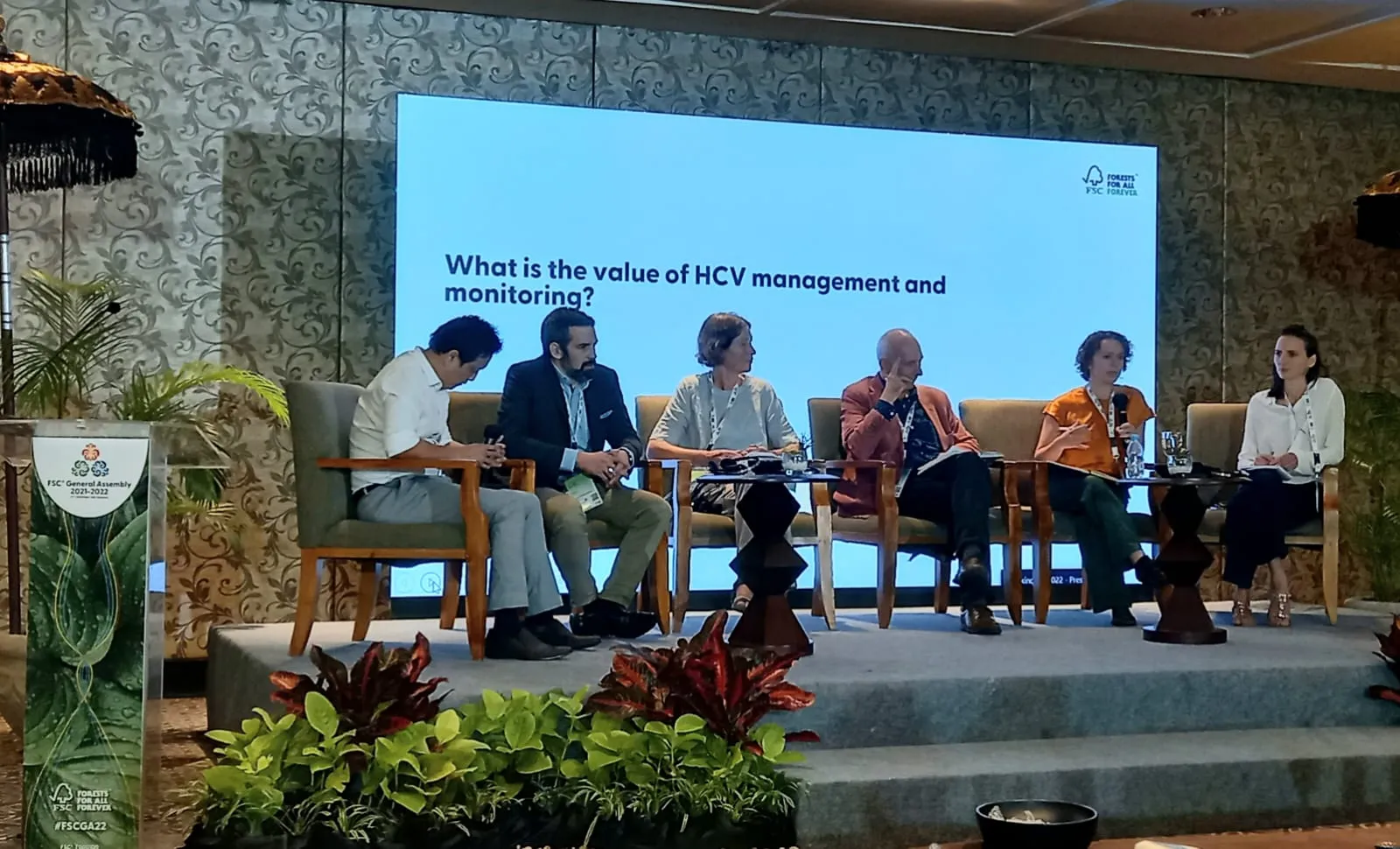
FSC Regenerative Natural Rubber side session
Rubber plantations can be FSC-certified, and the newly passed Motion 37 provides an avenue for FSC to eventually certify rubber plantations established between 1994 and 2020.
Arie Soetjiadi from the HCV Network Secretariat participated in a side session to share the HCV Network’s experience as a Founding Member of the Global Platform for Sustainable Natural Rubber (GPSNR) and active involvement in several working groups and caucuses since early 2019. Arie reiterated that GPSNR and FSC complement each other and highlighted the importance of trans-sectoral collaboration.
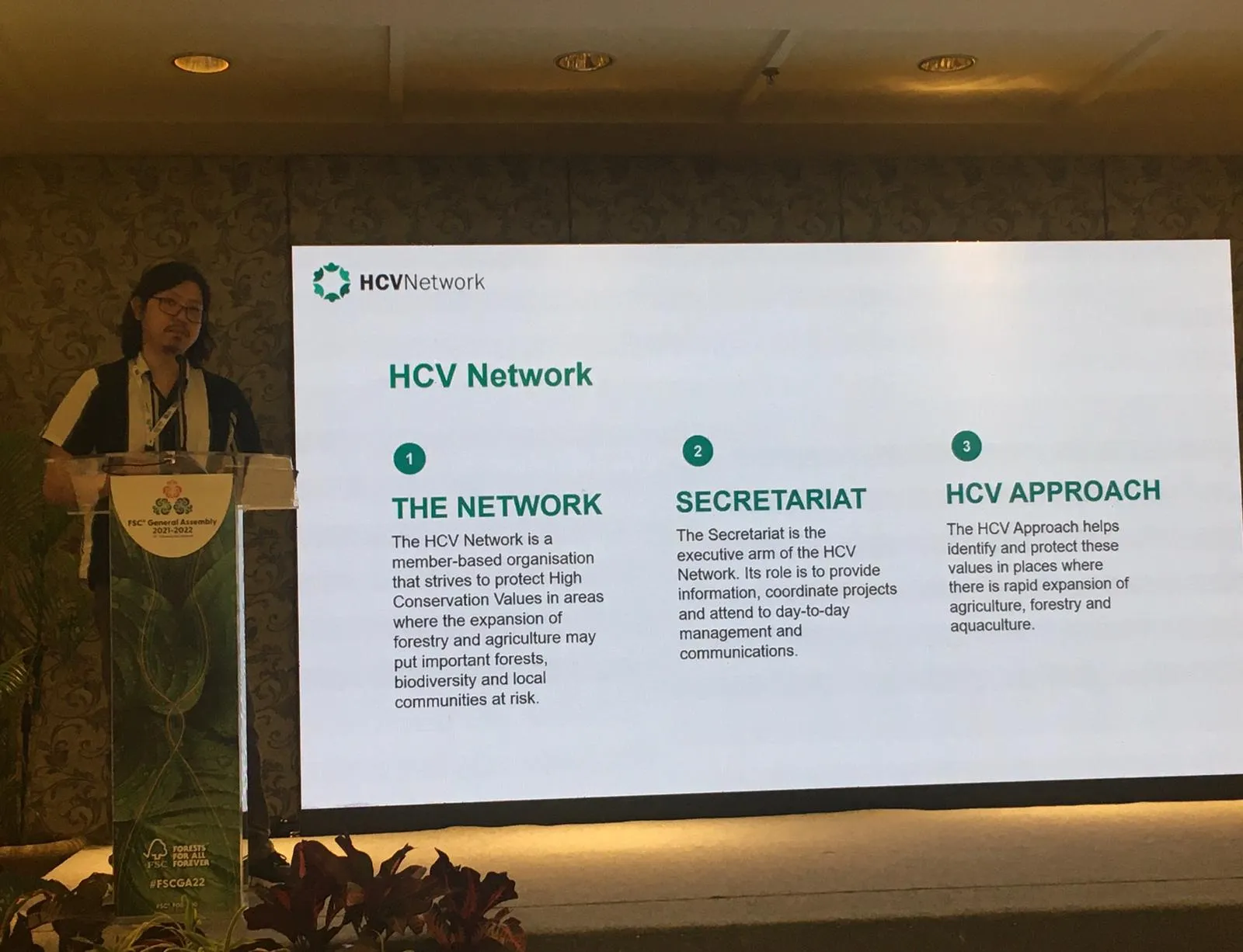
Interview
Finally, Preferred by Nature, an active member of the HCV Network, interviewed Olivia Scholtz about how the HCV Approach is used in the FSC system and beyond, and the opportunities that lie ahead, such as scaling up efforts to protect High Conservation Values in landscapes and jurisdictions.
Questions?
To learn more, please contact secretariat@hcvnetwork.org
Related Posts
Protegiendo el carácter ambiental y social único del sureste de México con el Enfoque de AVC
Hace dos años, HCVN y FEMEXPALMA firmaron un acuerdo de cooperación para promover prácticas sostenibles de producción de aceite de palma a través de la conservación, el desarrollo de capacidades y la divulgación. Hoy, el involucramiento de los pequeñosproductores se ha vuelto esencial en la protección de los Altos Valores de Conservación.
Read MoreProtecting southeastern Mexico’s unique environmental and social character using the HCV Approach
Two years ago, HCVN and FEMEXPALMA signed a cooperation agreement to promote sustainable practices in palm oil production through conservation, capacity building, and outreach. Today, the contributions of small-scale producers have become essential in the protection of High Conservation Values.
Read MoreDébloquer des incitations pour des solutions fondées sur la nature avec les communautés forestières
L'outil Forest Integrity Assessment (FIA) est une approche de liste de contrôle simple et conviviale conçue pour permettre aux gestionnaires de terres et à d'autres non-biologistes d'effectuer des estimations rapides et efficaces de l'état de la biodiversité forestière.
Read MoreOur Partnerships
Alongside many global initiatives, our work with partners promotes practices that help meet the global Sustainable Development Goalsand build a greener, fairer, better world by 2030.


Femexpalma
In April 2022, FEMEXPALMA and the HCV Network signed a 5-year cooperation agreement to promote sustainable production of palm oil in Mexico. FEMEXPALMA is a Mexican independent entity that represents palm production at the national level and promotes the increase of productivity in a sustainable way.
With global markets becoming stricter, for Mexican producers to be able to export to key markets such as the European Union, they must meet strict requirements such as certification by the Roundtable on Sustainable Palm Oil (RSPO). To be certified by RSPO, the HCV Approach must be applied prior to the establishment of any new oil palm plantations. With this cooperation agreement, the HCV Network will support FEMEXPALMA’s members and allies to design better strategies to identify, manage and monitor High Conservation Values and support smallholders to achieve RSPO certification and implement good agricultural practices.


High Carbon Stock Approach
The High Carbon Stock Approach (HCSA) is an integrated conservation land use planning tool to distinguish forest areas in the humid tropics for conservation, while ensuring local peoples’ rights and livelihoods are respected.
In September 2020, HCV Network and the HCSA Steering Group signed a five-year Memorandum of Understanding (MoU) to strengthen their collaboration to conserve forests and uphold community rights in tropical forests. The HCS and HCV Approaches are cornerstones of corporate no deforestation and conservation commitments, and increasingly for actors working at different scales. The collaboration aims to further support effective implementation of these commitments through increased uptake of the HCV and HCS tools.
Through this MoU, HCSA and HCVRN are pursuing two main strategic goals:
- Strive to promote the application of the two approaches in tropical moist forest landscapes and explore further opportunities for collaboration.
- Ensure that, where the two approaches are applied together, this happens in a coordinated, robust, credible, and efficient manner, so that HCS forests and HCVs are conserved, and local peoples’ rights are respected.


World Benchmarking Alliance
From May 2022, the HCV Network is an ally at the World Benchmarking Alliance (WBA). WBA is building a diverse and inclusive movement of global actors committed to using benchmarks to incentivise, measure, and monitor corporate performance on the SDGs, and will assess and rank the performance of 2,000 of the world’s most influential companies against seven systems of transformation by 2023.
The scope of WBA’s circular transformation was expanded to cover nature and biodiversity as recognition of the need for greater understanding, transparency and accountability of business impact on our environment. The WBA Nature Benchmark was launched in April 2022, which will be used to rank keystone companies on their efforts to protect our environment and its biodiversity. As HCV Areas are recognised as key areas important for biodiversity, companies that publicly disclose their actions to identify and protect HCVs will contribute to the assessment of their performance against the benchmark.


Taskforce on Nature-related Financial Disclosures - TNFD
The Taskforce on Nature-related Financial Disclosures (TNFD) is a global, market-led initiative, established with the mission to develop and deliver a risk management and disclosure framework for organizations to report and act on evolving nature-related risks, with the aim of supporting a shift in global financial flows away from nature-negative outcomes and toward nature-positive outcomes.
In April 2022, the HCV Network joined the TNFD Forum. The TNFD Forum, composed of over 400 members, is a world-wide and multi-disciplinary consultative network of institutional supporters who share the vision and mission of the task force.
By participating in the Forum, the HCV Network contributes to the work and mission of the taskforce and help co-create the TNFD Framework which aims to provide recommendations and advice on nature-related risks and opportunities relevant to a wide range of market participants, including investors, analysts, corporate executives and boards, regulators, stock exchanges and accounting firms.


Aquaculture Stewardship Council
The Aquaculture Stewardship Council (ASC) is the world’s leading certification scheme for farmed seafood – known as aquaculture – and the ASC label only appears on food from farms that have been independently assessed and certified as being environmentally and socially responsible. In 2021, the HCV Network and ASC formalised their collaboration through a Memorandum of Understanding (MoU). The MoU represents the first step in a fruitful relationship aimed at conserving HCVs in aquaculture. Although, existing guidance on the use of the HCV Approach currently focuses mainly on forestry and agriculture, the HCV Approach is however generic, and in principle also applicable to aquatic production systems. Through this MoU, this is recognised by the Aquaculture Stewardship Council (ASC) in their ASC farm standard, in which the protection of HCV areas is mentioned in the context of expansion


Accountability Framework Initiative
The Accountability Framework initiative (AFi) is a collaborative effort to build and scale up ethical supply chains for agricultural and forestry products. Led by a diverse global coalition of environmental and human rights organizations, the AFi works to create a “new normal” where commodity production and trade are fully protective of natural ecosystems and human rights. To pursue this goal, the coalition supports companies and other stakeholders in setting strong supply chain goals, taking effective action, and tracking progress to create clear accountability and incentivize rapid improvement. In July 2022, the HCV Network joined AFi as a Supporting Partner. AFi Supporting Partners extend the reach and positive impact of the AFi by promoting use of the Accountability Framework by companies, industry groups, financial institutions, governments, and other sustainability initiatives, both globally and in commodity-producing countries.


Biodiversity Credit Alliance
The Biodiversity Credit Alliance (BCA) is a global multi-disciplinary advisory group formed in late 2022. Its mission is to bring clarity and guidance on the formulation of a credible and scalable biodiversity credit market under global biodiversity credit principles. Under these principles, the BCA seeks to mobilize financial flows towards biodiversity custodians while recognising local knowledge and contexts.
The HCVN joined the BCA Forum in August 2023 to learn more from the many organizations already coming together to find effective pathways to opening up credit-based approaches, and how to contribute our knowledge and experience of years of working in a practical way, often with global sustainability standards and their certified producers, to protect what matters most to nature and people.
.webp)
.webp)
Nature Positive Forum
The Nature Positive Initiative is a group of stakeholders coming together to find ways to unlock success and achieve Nature Positive - a global societal goal defined as ‘halt and reverse nature loss by 2030 on a 2020 baseline, and achieve full recovery by 2050’, in line with the mission of the Kunming-Montreal Global Biodiversity Framework.
Core work includes preserving the integrity of ‘Nature Positive’ as a measurable 2030 global goal for nature for business, government, and other stakeholders, and providing the tools and guidance necessary to allow all to contribute. The initiative also advocates for the full implementation of the Kunming-Montreal Global Biodiversity Framework by governments and other stakeholders.
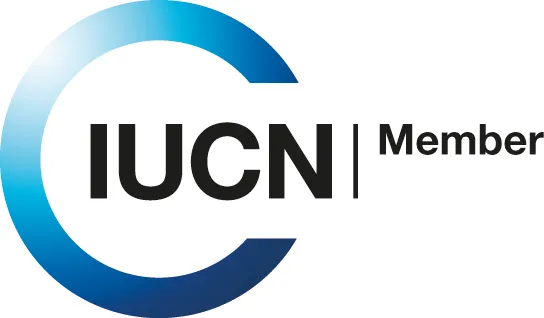

IUCN
IUCN is a membership Union uniquely composed of both government and civil society organisations. It provides public, private, and non-governmental organisations with the knowledge and tools that enable human progress, economic development, and nature conservation to take place together.
Created in 1948, IUCN is now the world’s largest and most diverse environmental network, harnessing the knowledge, resources and reach of more than 1,400 Member organisations and around 15,000 experts. It is a leading provider of conservation data, assessments, and analysis. Its broad membership enables IUCN to fill the role of incubator and trusted repository of best practices, tools, and international standards.
IUCN provides a neutral space in which diverse stakeholders including governments, NGOs, scientists, businesses, local communities, indigenous peoples’ organisations, and others can work together to forge and implement solutions to environmental challenges and achieve sustainable development.
Working with many partners and supporters, IUCN implements a large and diverse portfolio of conservation projects worldwide. Combining the latest science with the traditional knowledge of local communities, these projects work to reverse habitat loss, restore ecosystems, and improve people’s well-being.

Get Involved
Our Mission as a network is to provide practical tools to conserve nature and benefit people, linking local actions with global sustainability targets.
We welcome the participation of organisations that share our vision and mission to protect and enhance High ConservationValues and the vital services they provide for people and nature. By collaborating with the Network, your organisation can contribute to safeguarding HCVs while gaining valuable insights and connections that support your sustainability goals.
We are seeking collaborative partners to help expand and enhance our work, as well as talented professionals who can join the growing Secretariat team, and for professionals who can contribute to the credible identification of High Conservation Values globally.
Join us in securing the world’s HCVs and shaping a sustainable future.
